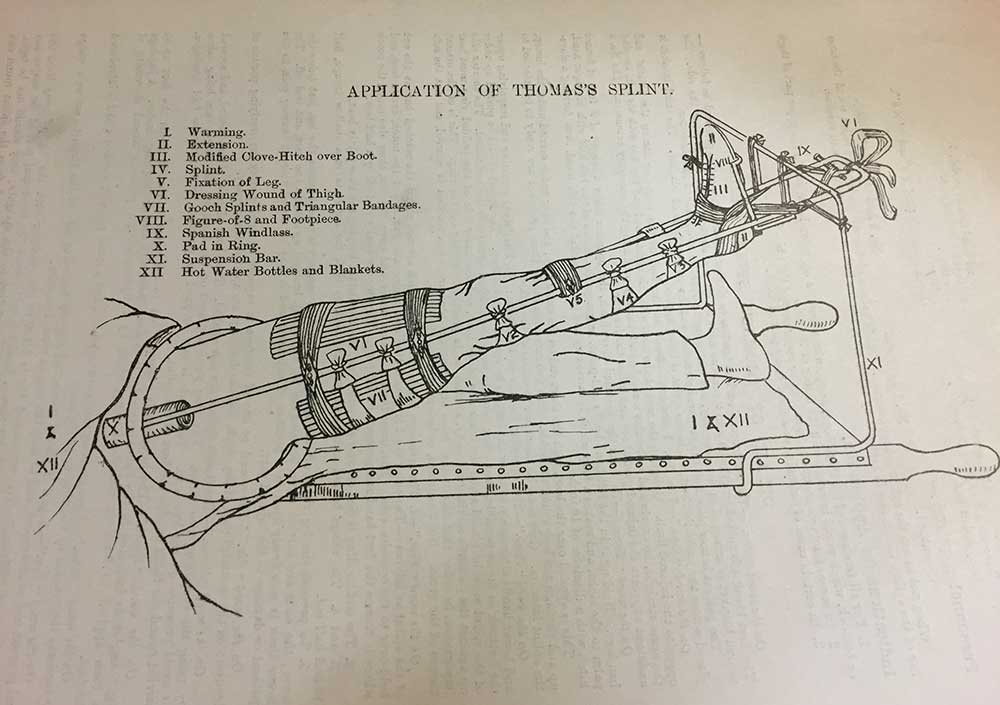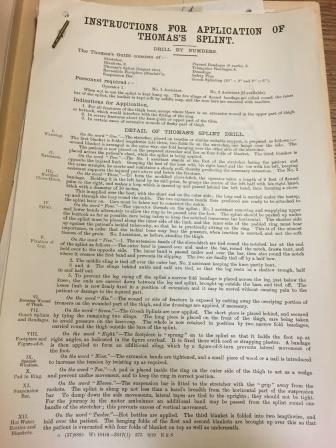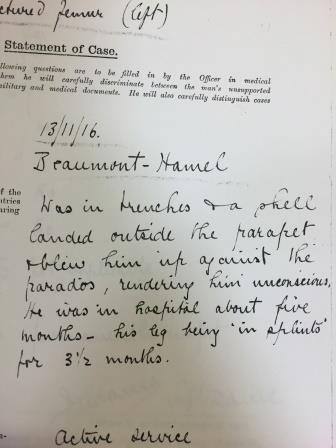Ever since seeing a demonstration of how to use it, in a reconstruction of a Casualty Clearing Station in Heaton Park, I have been interested in the Thomas splint. This splint revolutionised the manner in which men injured in the First World War were treated.
Introduced in 1916 to the Front, the Thomas splint reduced the rate of mortality from fractures (of the femur in particular) from 80% to 20%, in 1918. [ref] 1. Colonel H.W. Orr, ‘The Use Of The Thomas Splint’ in ‘The American Journal of Nursing’, Vol. 20, No. 11 (Aug., 1920) pp. 879-880 [/ref] The splint was originally designed by Hugh Owen Thomas, considered the father of orthopaedic surgery in Britain, with the intention that it would stabilise a fracture and prevent infection. However, it was not fully appreciated until his nephew, Robert Jones, introduced it for use in the war.
Thus far, I have only uncovered one thin file relating to the Thomas splint in our collections. But the information it contains is rich. There is a wonderful diagram of the Thomas splint in use, which relates to an instruction leaflet of how to properly apply it.

Application of the Thomas splint (catalogue reference: AIR 2/136)

Instructions for application of Thomas’s splint (catalogue reference: AIR 2/136)
The instructions for application contain the following suggestions as to when it should be applied:
- For all fractures of the thigh bone, except where there is an extensive wound in the upper part of thigh or buttock, which would interfere with the fitting of the ring
- In severe fractures about the knee-joint or upper part of the tibia.
- In certain cases of extensive wounds of fleshy part of thigh.
As Robert Jones states in his book ‘Notes On Military Orthopaedics’ these types of wounds need patience and time, which the Thomas splint can help with. He disparages those practitioners who do not take care to achieve accurate alignment, as they get nervous after a number of weeks and interfere with what he refers to as ‘delayed union’ – which can lead to a permanent disability.[ref] 2. Robert Jones, ‘Notes On Military Orthopaedics’ (United Kingdom: Cassell, 1917) p.60 [/ref]
Ideally, a team of three is required to apply the splint (an operator and two assistants) but it could be undertaken by just two members of the team, if necessary. There are 12 different stages in the application of the splint, which all serve to make the patient as comfortable as possible – including the last stage of applying hot water bottles. The main goal of this is to be able to move the patient without causing him pain, or any further damage to the injured part.

George Henry Prentice (catalogue reference: PIN 26/4144)
If you look through our Ministry of Pension files relating to those awarded for the First World War (in PIN 26) and search for ‘femur’, a number of men who suffered from fractured femurs are represented. One such man, Private George Henry Prentice, was in the trenches at Beaumont Hamel when a shell landed outside the parapet and blew him against the wall, rendering him unconscious. Within all of this, his left femur was also fractured. The most interesting part of his file is the section which states that his leg was ‘in splints’ for three and a half months. It doesn’t indicate specifically that this was a Thomas splint, but it is a possibility.
Further reading of his file shows that George did end up walking with a slight limp after his treatment. However, this is a much better outcome than that which other men had to deal with – there was no loss of limb or death in this situation. George suffered this injury in November 1916, which links nicely with the idea that treatment for fractured femurs had started to improve by this point.
Related blogs
‘Maimed and not fit for manual labour’?
Medical units in the First World War
St. Dunstan’s Hostel for Blind Soldiers and Sailors
How three men saved countless lives: blood transfusion in the First World War
[…] techadmin on December 1, 2016 A revolution in treatment: the Thomas splint2016-12-01T09:46:16+00:00 – Journals & Publications – No […]
Have seen and held the Thomas splint but until now had not known the history of it would love to actually fit one in order to see it work
Having trained as an orthopaedic nurse in 1971 I have applied and taught how to apply many Thomas Splints there is an art to application it can be also be used to treat fractures along with traction and also as a rest splint for patients with TB of The Knee it was used by the army ( and me ) up to the time I left in 1997 I can’t tell you if they are still in use but I would hazard a guess that they are the ring is no longer solid which makes application easier as they did come with a buckle fastening on the outside. Hope this helps
My father used a Thomas Splint to mend an adult cows broken leg many years ago. I still have the splint which he had made. It was fitted slightly differently to a bovine in that it fitted between the cleft hoof and was secured with wire stapled to the hard part of hoof. It worked by taking the animals weight from shoulder to ground and therefore allowed the leg to heal. The leg was strapped to the long bars and the straps acted as supports and straighteners at the same time.
Henry Wade was a great advocate for the use of the Thomas Splint and pressed Allenby to order its supply in large numbers.
[…] https://blog.nationalarchives.gov.uk/blog/thomas-splint/ […]
I had a Thomas traction fitted in 1975 age 13. I had osteomyelitis and fractured femur (site of osteomyelitis) whilst recovering in hospital. I was left with a severely bent leg. In 2012 I had a plate fitted the length of the femur to straighten in part my leg. I would love to know, for my own information, if the Thomas Traction splint may have caused the deformity of my leg.